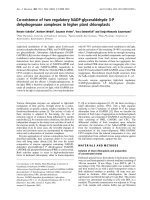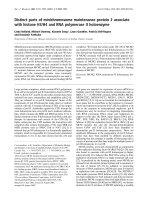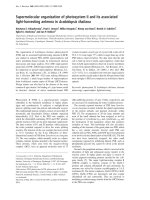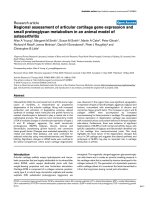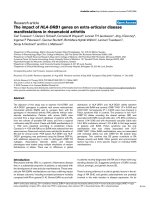Báo cáo y học: " Long-term result of hybrid procedure for an extensive thoracic aortic aneurysm in Takayasu arteritis: a case report" pptx
Bạn đang xem bản rút gọn của tài liệu. Xem và tải ngay bản đầy đủ của tài liệu tại đây (1019.19 KB, 5 trang )
CAS E REP O R T Open Access
Long-term result of hybrid procedure for an
extensive thoracic aortic aneurysm in Takayasu
arteritis: a case report
Yukio Obitsu
*
, Nobusato Koizumi, Naozumi Saiki, Satoshi Kawaguchi, Hiroshi Shigematsu
Abstract
We herein present a 60 yea rs old woman with Takayasu arteritis and an extensive thoracic aortic aneurysm who
initially underwent a total aortic arch replacement. Then, in the second stage, thoracic endovascular aortic repair
was performed using the elephant trunk graft as the proximal landing zone at four weeks after aortic arch repair.
The postoperative course was relatively uncomplicated, but a type II endoleak was noted. Currently, about 5 years
postoperatively, the slight type II endoleak from intercostal artery persists, but aneurism dilatation has not been
noted, so the patient is being followed up.
Background
Single-stage surgery is preferable for extensive thoracic
aortic aneurysms, but because of the excessive inv asive-
ness of this approach, staged surgery must sometimes
be performed. When staged surgery is selected, rupture
of the residual lesion during the interval period is always
a concern, so the second stage of surgery must be
scheduled as soon as possible after the first. We here in
present a patient with Takayasu arteritis and an exten-
sive thoracic aortic aneurysm who initially underwent a
total aortic arc h replacement. Then, in the second stage,
thoracic endovascular aortic repair (TEVAR) was per-
formed using the elephant trunk graft as the proximal
landing zone. Long-term results have been satisfactory.
Case presentation
A 60-year-old woman w ho had been given a diagnosis
of Takayasu arteritis about 20 years previously was
being treated with steroids, but because of progressive
dilat ation of the ascending to mid-descending aorta, she
was hospitalized for treatment (Figure 1). Further e va-
luation on admission revealed no complications, but
because of susceptibility to infection due to long-term
oral steroids, staged hybrid surgery with TEVAR was
planned.
In May 2005, extracorporeal circulation was established,
then total aortic arch replacement was performed under
selective cerebral perfusion. The vascular graft was a
4-branched Intergard-W (Intervascular, Flagstaff, AZ,
USA). Circulation of the body was arrested at a core tem-
perature of 26°C. An open distal anastomosis was per-
formed with the elephant trunk procedure (diameter
24 mm, length 8 cm). After distal anastomosis, proximal
anastomosis and branch arteries reconstruction were per-
formed. Extracorporeal circulation time was 142 min, and
circulatory arrest of the body time was 36 min (Figure 2).
Four weeks after arch repair, TEVAR was performed
using the elephant trunk as the proximal landing zone.
The stent graft was handmade by the surgical staff by
connecting modified stainless steel Z stents using two
support wires and was covered with an expanded polyte-
trafluoroethylene artificial vessel, with a window to pre-
serve the left subclavian artery [1]. To ensure a
sufficient proximal landing zone, the stent graft was
placed across the distal anastomosis (Figure 3).
The postoperative course was relatively uncompli-
cated, but a type II endolea k from intercostal artery was
noted. Currently, about 5 years postoperatively, slight
thetypeIIendoleakpersists, but aneurysm dilatation
has not been noted, so the patient is being followed up
(Figure 4).
Extensivethoracicaorticaneurysmsarenotuncom-
mon in clinical practice, and the surgeon must decide
whether to perform single-stage or multistage surgery.
* Correspondence:
Department of Vascular Surgery, Tokyo Medical University, 6-7-1
Nishishinjuku, Shinjuku-ku, Tokyo 160-0023, Japan
Obitsu et al. Journal of Cardiothoracic Surgery 2010, 5:28
/>© 2010 Obitsu et al; licensee BioMed Central Ltd. This is an Open Access article distributed under the terms of the Creative Commons
Attribu tion License ( es/by/2.0), which permits unrestricted use, dis tribution, and reproduction in
any medium, provide d the original work is prop erly cited.
Figure 1 3DCT scan obtained on admission, showing extensive thoracic aortic aneurysms.
Obitsu et al. Journal of Cardiothoracic Surgery 2010, 5:28
/>Page 2 of 5
In cases with multiple adjacent aneurysms, a single-step
procedure is theoretically possible, but because of exces-
sive invasiveness, surgical outcomes may be poor [2,3].
According to a report by the Japanese Association for
Thoracic Surgery, the hospital mortality rate after arch-
descending aortic replacement is significan tly worse
than after TAR (14.3% vs. 6.5%, p < 0.001)[2]. Kouchou-
kos et al [3] performed single-stage repair using a clam-
shell incision in 46 patients and reported hospital death
in only 3 patients (6.5%). However, 17% required a
rethoracotomy f or hemostasis, and other complications
in survivors were reported, including mechanical ventila-
tion for 72 hours or more in 42% (tracheotomy in 13%),
and transient cerebral ischemia in 13%. On the o ther
hand, when multistage surgery is selected to reduce sur-
gical invasiveness, the surgical priority of multiple
aneurysms must be decided based on diameter, mor-
phology, and propensity for dilatation; and because of
the risk of rupture during the interval between the two
stages, the second stage of surgery must be scheduled as
soon as possible after the first. Safi et al. [4] reported a
mortality rate of 5.1% for the first stage and 6.2% for the
second stage. The mortality rate during the interval
between operations was 3.6%, of which 75% were the
result of aneurysm rupture.
For a second-stage TEVAR after arch repair, a left
thoracotomy is not necessary, so early second-stage sur-
gery can be performed; however, there are few case
reports, so long-term results are unknown. In 22
patients who underwent arch repair, Greenberg et al. [5]
performed TEVAR using the elephant trunk as the
proximal landing zone. They reported good mid-term
Figure 2 After total aortic arch replacement with an elephant trunk procedure.
Obitsu et al. Journal of Cardiothoracic Surgery 2010, 5:28
/>Page 3 of 5
Figure 3 Second-stage TEVAR using the elephant trunk graft as the proximal landing zone.
Figure 4 The slight type II endoleak persists, but aneurysm dilatation has not been noted for 5 years postoperatively.
Obitsu et al. Journal of Cardiothoracic Surgery 2010, 5:28
/>Page 4 of 5
results after a mean follow-up period of 17.8 months,
with aneurysm-related mortality of 4.5% at 1 month,
11.3% at 1 year, and 11.3% at 2 years.
Conclusion
The present patient still has a type II endoleak, but
aneurysm dilatation has not been note d, with good long-
term results. Early second-stage surgery was possible
only 4 weeks after initial surgery. However, TEVAR for
aortic aneurysms in Takayasu arteritis has rarely been
reported [6,7], so long-term o utcomes are unknown.
Further careful clinical observation is therefore necessary.
Consent
Written informed consent was obtained from the patient
for publication of this case report and accompanying
images. A copy of the written consent is available for
review by the Editor-in-Chief of this journal.
Acknowledgements
The authors are indebted to prof. J. Patrick Barron of the Department
International Medical Communications of Tokyo Medical University for his
review of this manuscript.
Authors’ contributions
All authors read and approved the final manuscript. YO carried out the study
design, Data analysis and writing, NK, NS, SK and HS performed data
collection.
Competing interests
The authors declare that they have no competing interests.
Received: 21 March 2010 Accepted: 20 April 2010
Published: 20 April 2010
References
1. Kawaguchi S, Yokoi Y, Shimazaki T, Koide K, Matsumoto M, Shigematsu S:
Thoracic endovascular aneurysm repair in Japan: Experience with
fenestrated stent grafts in the treatment of distal arch aneurysms. J Vasc
Surg 2008, 48(6 Supple):24S-29S.
2. Ueda Y, Fujii Y: Thoracic and cardiovascular surgery in Japan during
2006. Gen Thorac Cardiovasc Surg 2008, 56:365-388.
3. Kouchoukos NT, Mauney MC, Masetti P, Castner CF: Single-stage repair of
extensive thoracic aortic aneurysms: Experience with the arch-first
technique and bilateral anterior thoracotomy. J Thorac Cardiovasc Surg
2004, 128 :669-676.
4. Safi HJ, Miller CC, Estrera AL, Huynh TT, Rubenstein FS, Subramaniam MH,
Buja LM: Staged repair of extensive aortic aneurysms: morbidity and
mortality in the elephant trunk technique. Circulation 2001,
104:2938-2942.
5. Greenberg RK, Haddad F, Svensson L, O’Neill S, Walker E, Lyden SP, Clair D,
Lytle B: Hybrid approaches to thoracic aortic aneurysms: The role of
endovascular elephant trunk completion. Circulation 2005, 112:2619-2626.
6. McGoldrick RB, Munneke GJ, Thompson MM: Endovascular treatment of
Takayasu’s Arteritis of the thoracic descending aorta. Eur J Vasc Endovasc
Surg 2007, 33:81-83.
7. Baril DT, Carroccio A, Palchik E, Elozy SH, Jacobs TS, Teodorescu V,
Marin ML: Endovascular treatment of complicated aortic aneurysms in
patients with underlying arteriopathies. Ann Vasc Surg 2006, 20:464-471.
doi:10.1186/1749-8090-5-28
Cite this article as: Obitsu et al.: Long-term result of hybrid procedure
for an extensive thoracic aortic aneurysm in Takayasu arteritis: a case
report. Journal of Cardiothoracic Surgery 2010 5:28.
Submit your next manuscript to BioMed Central
and take full advantage of:
• Convenient online submission
• Thorough peer review
• No space constraints or color figure charges
• Immediate publication on acceptance
• Inclusion in PubMed, CAS, Scopus and Google Scholar
• Research which is freely available for redistribution
Submit your manuscript at
www.biomedcentral.com/submit
Obitsu et al. Journal of Cardiothoracic Surgery 2010, 5:28
/>Page 5 of 5

